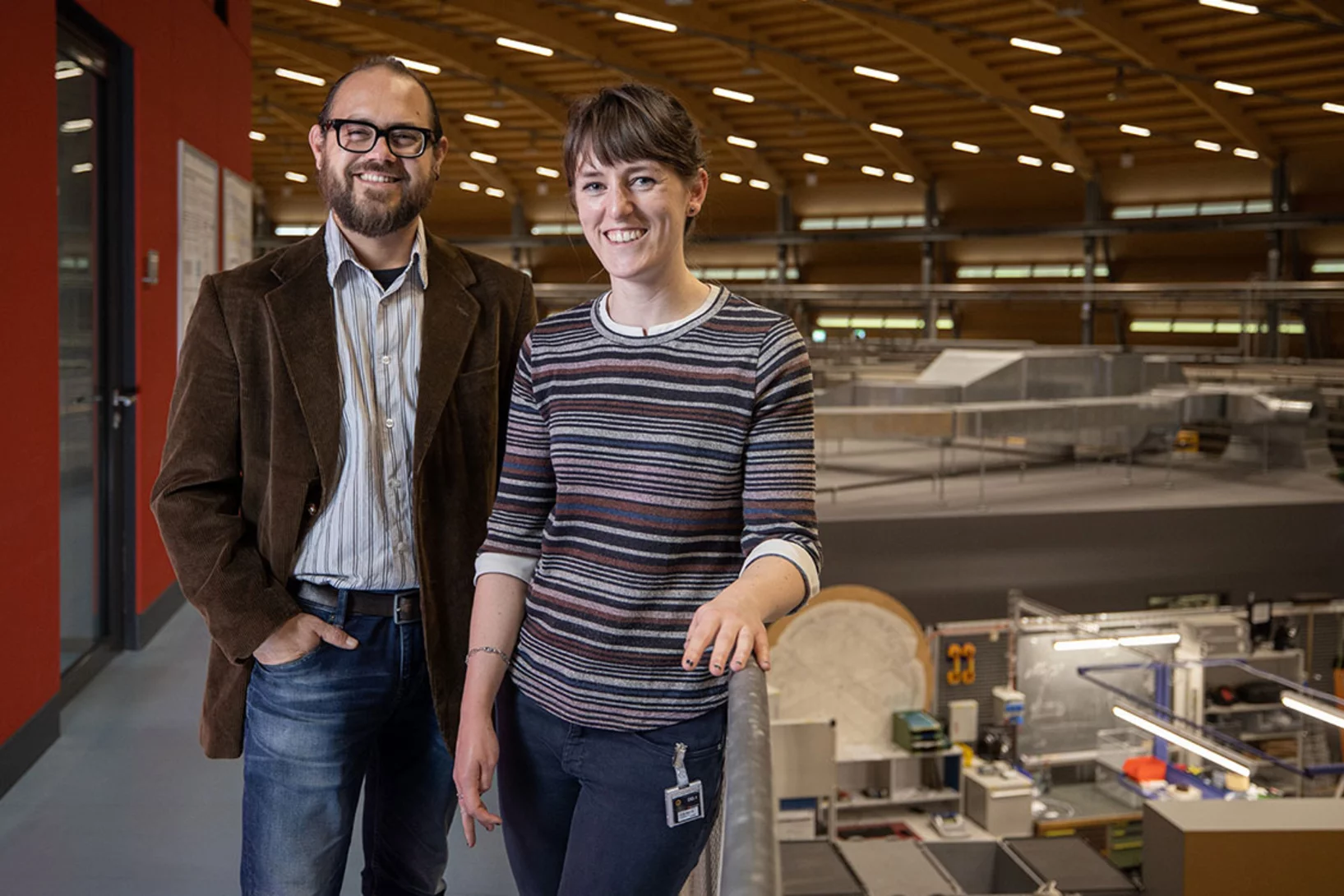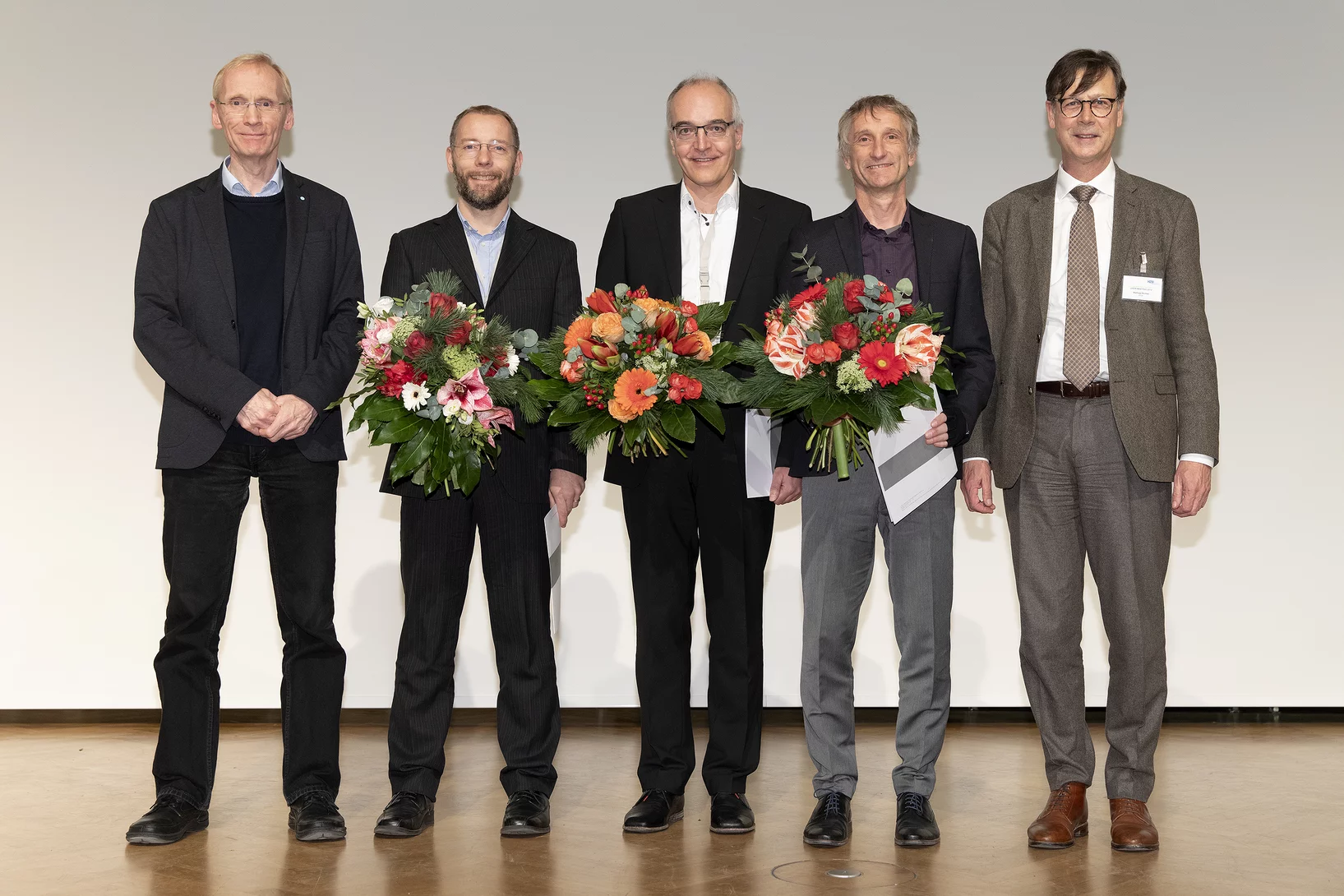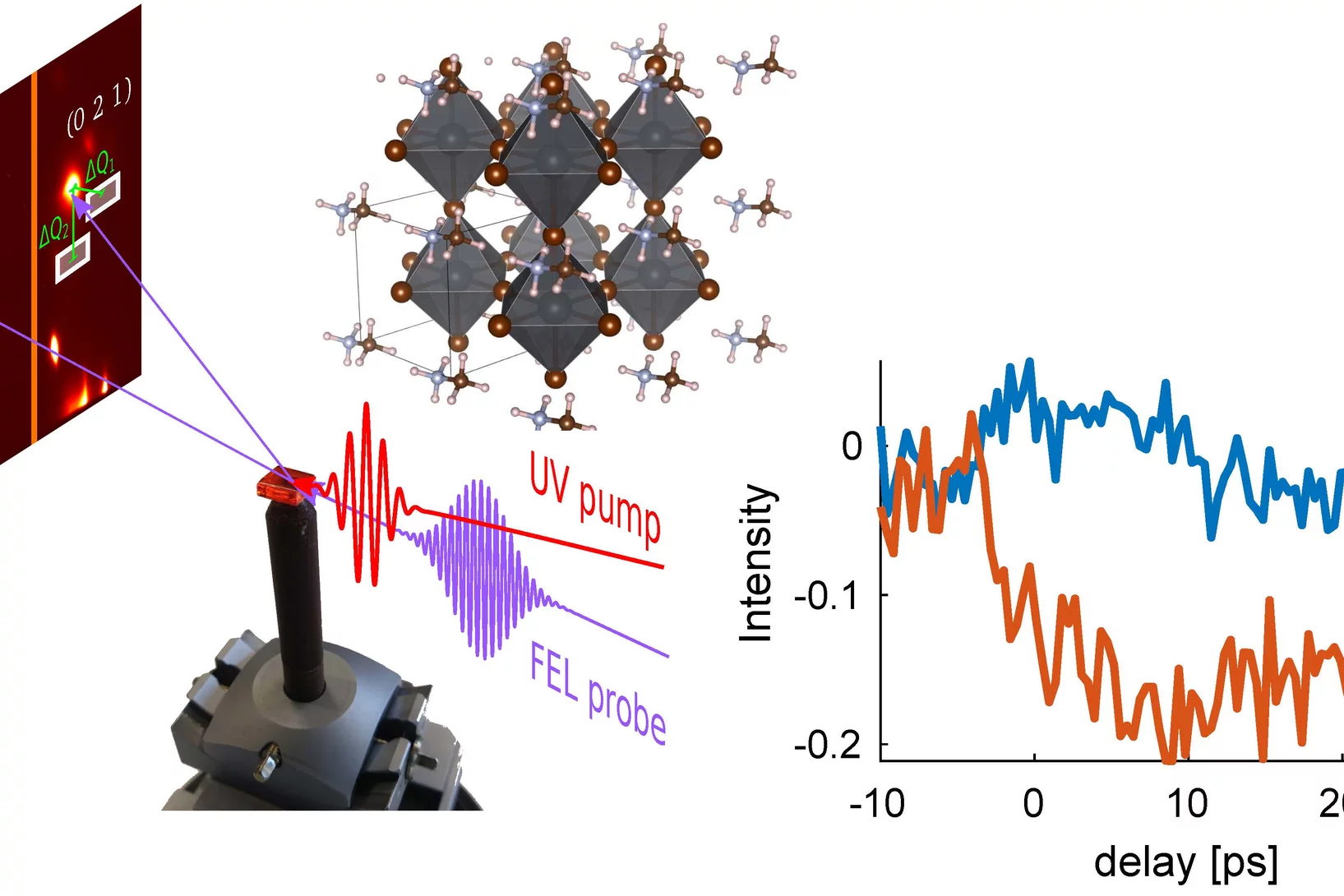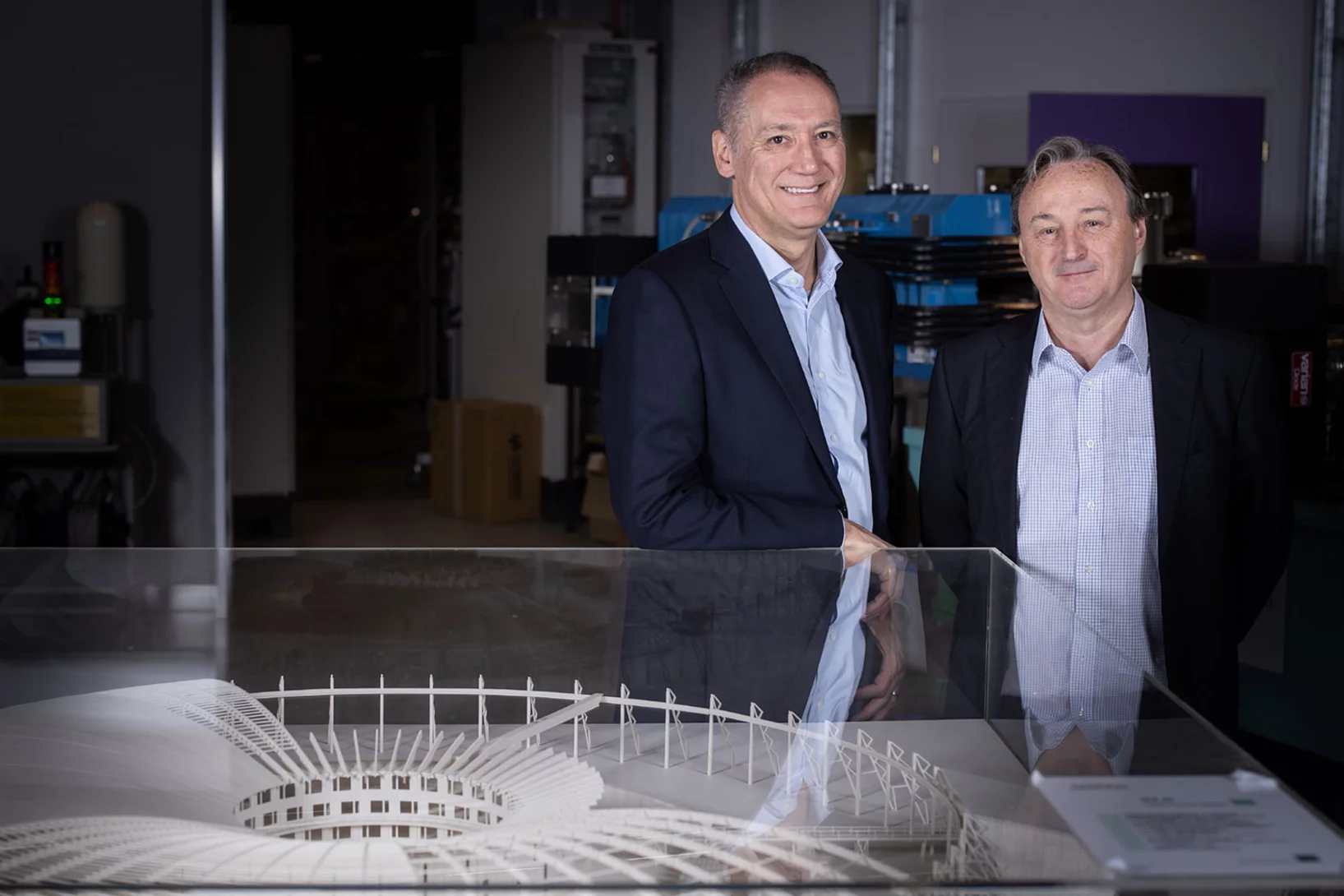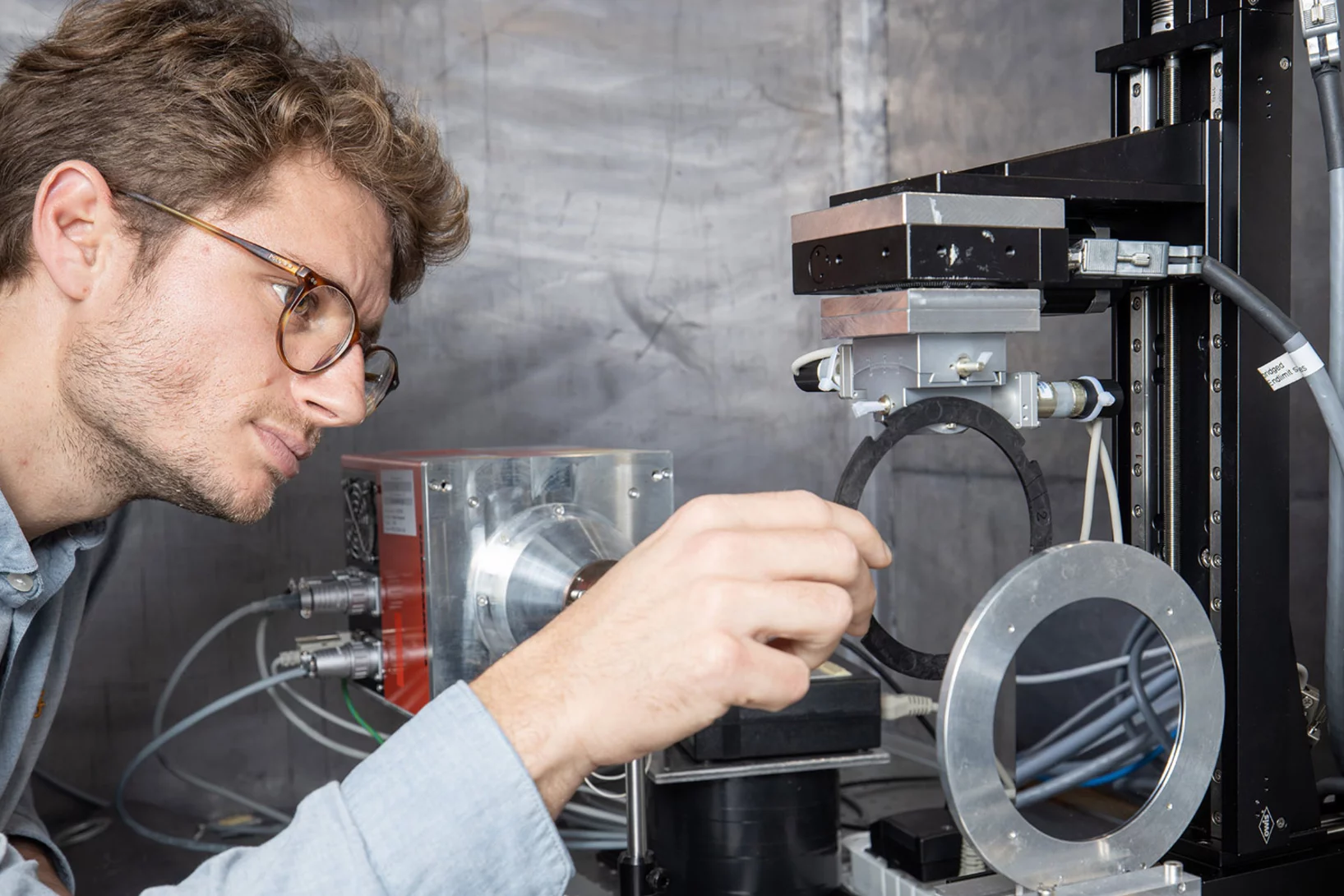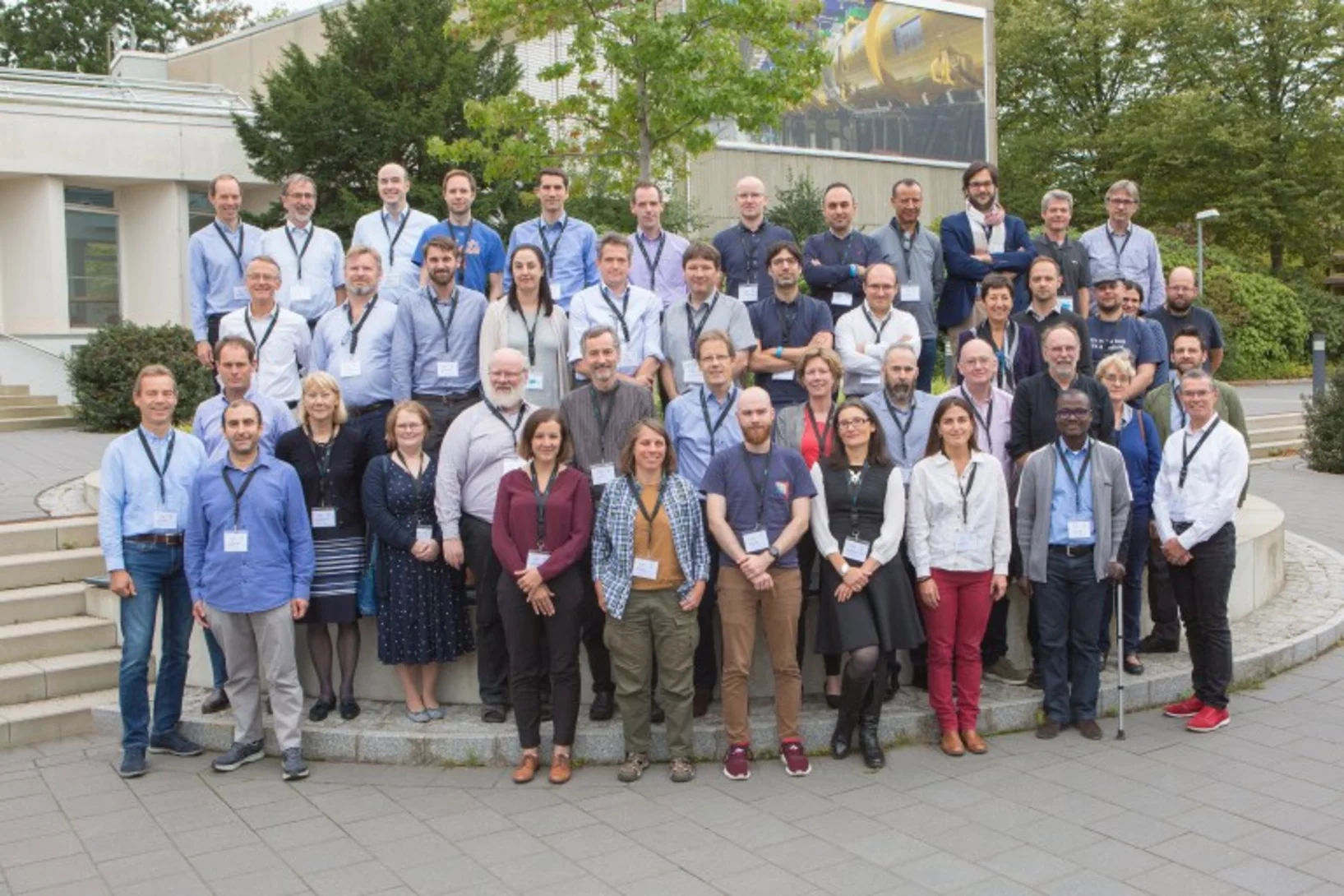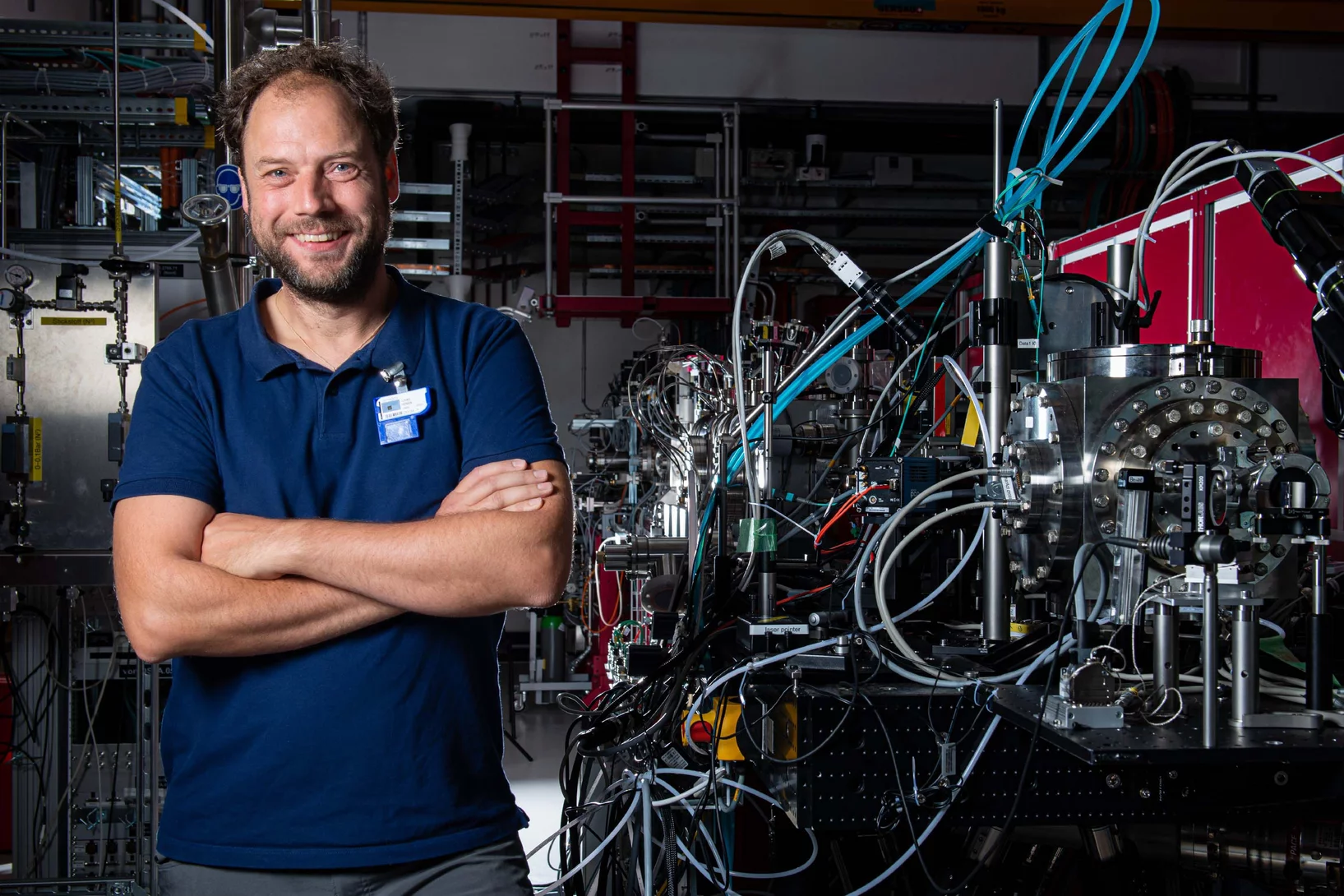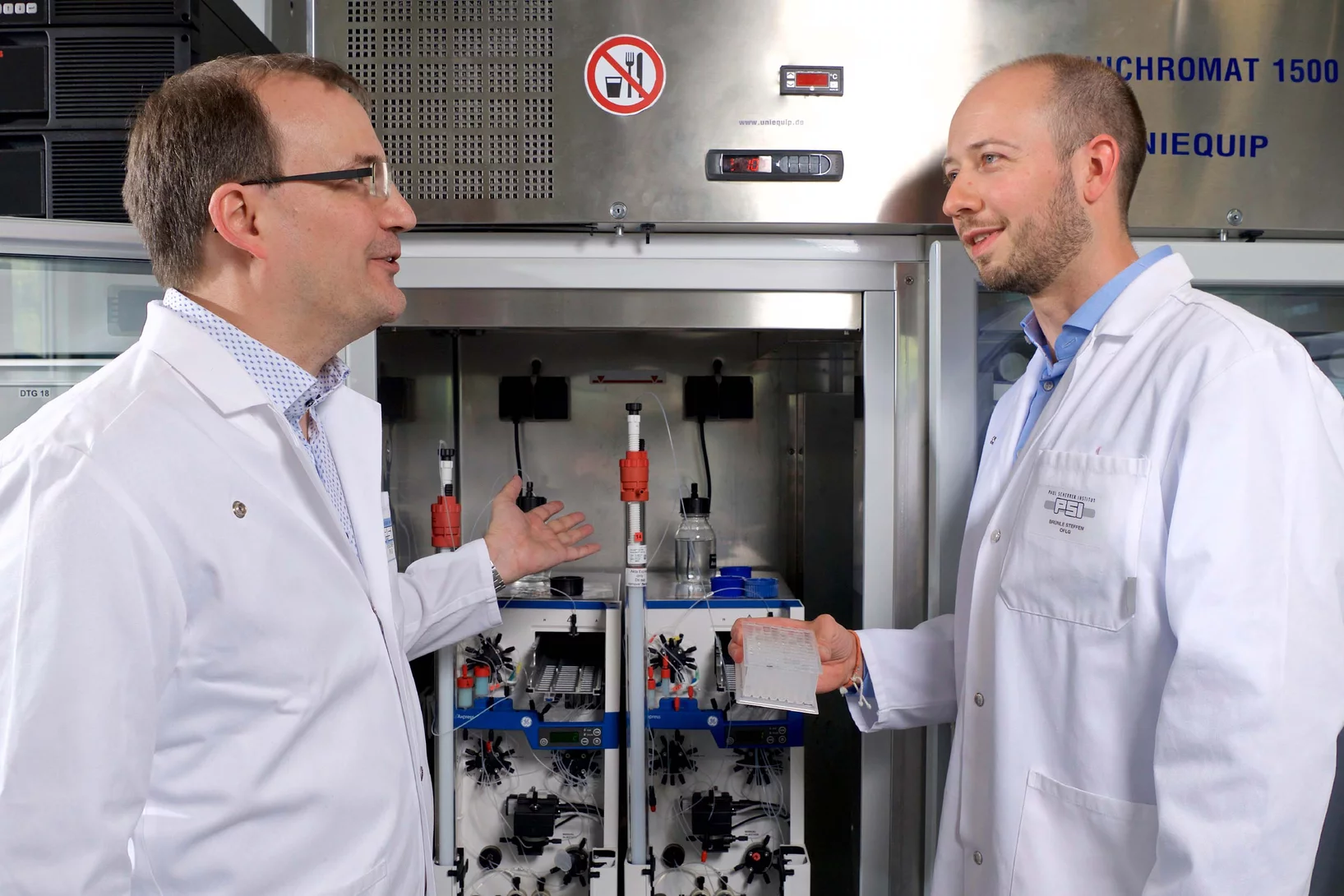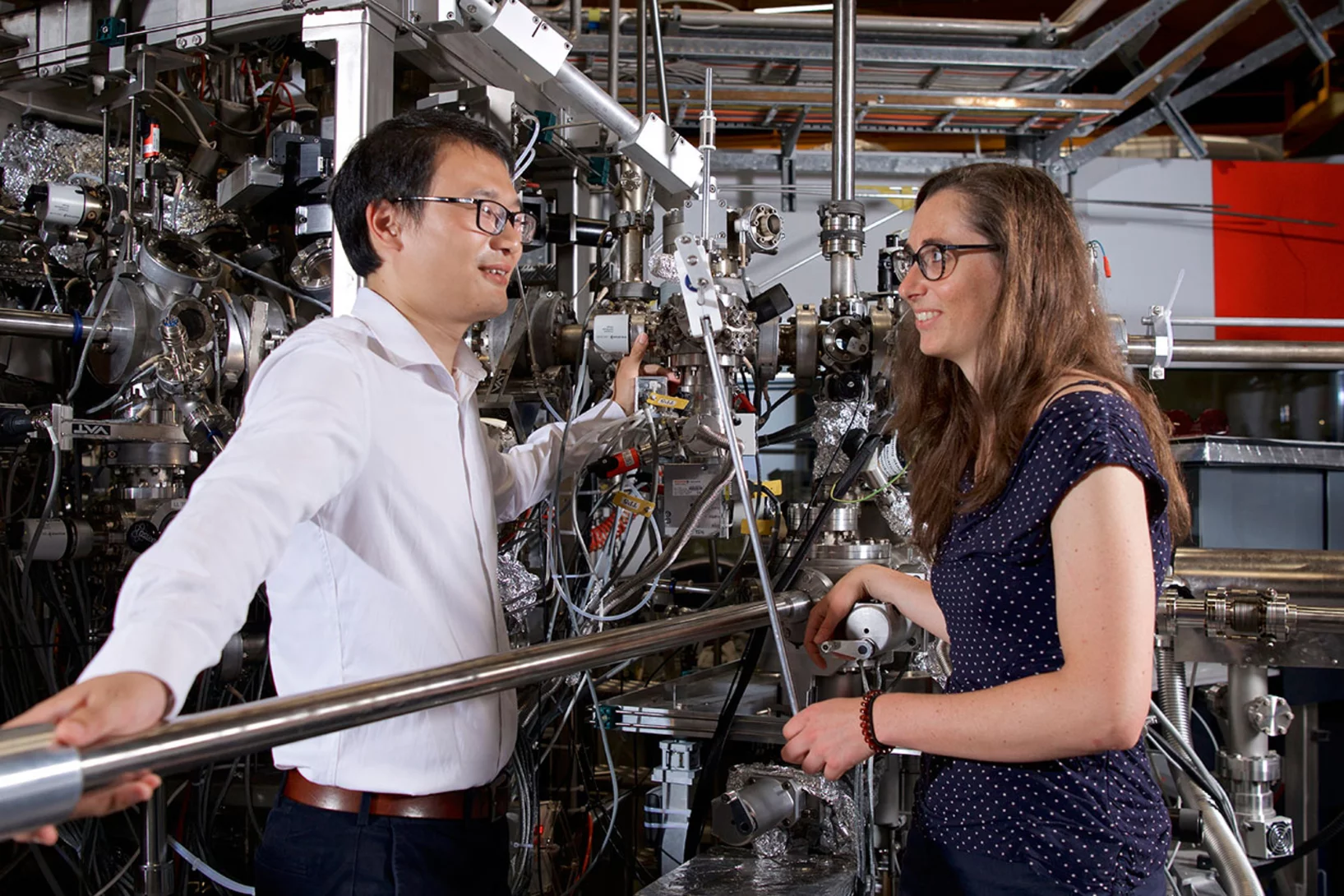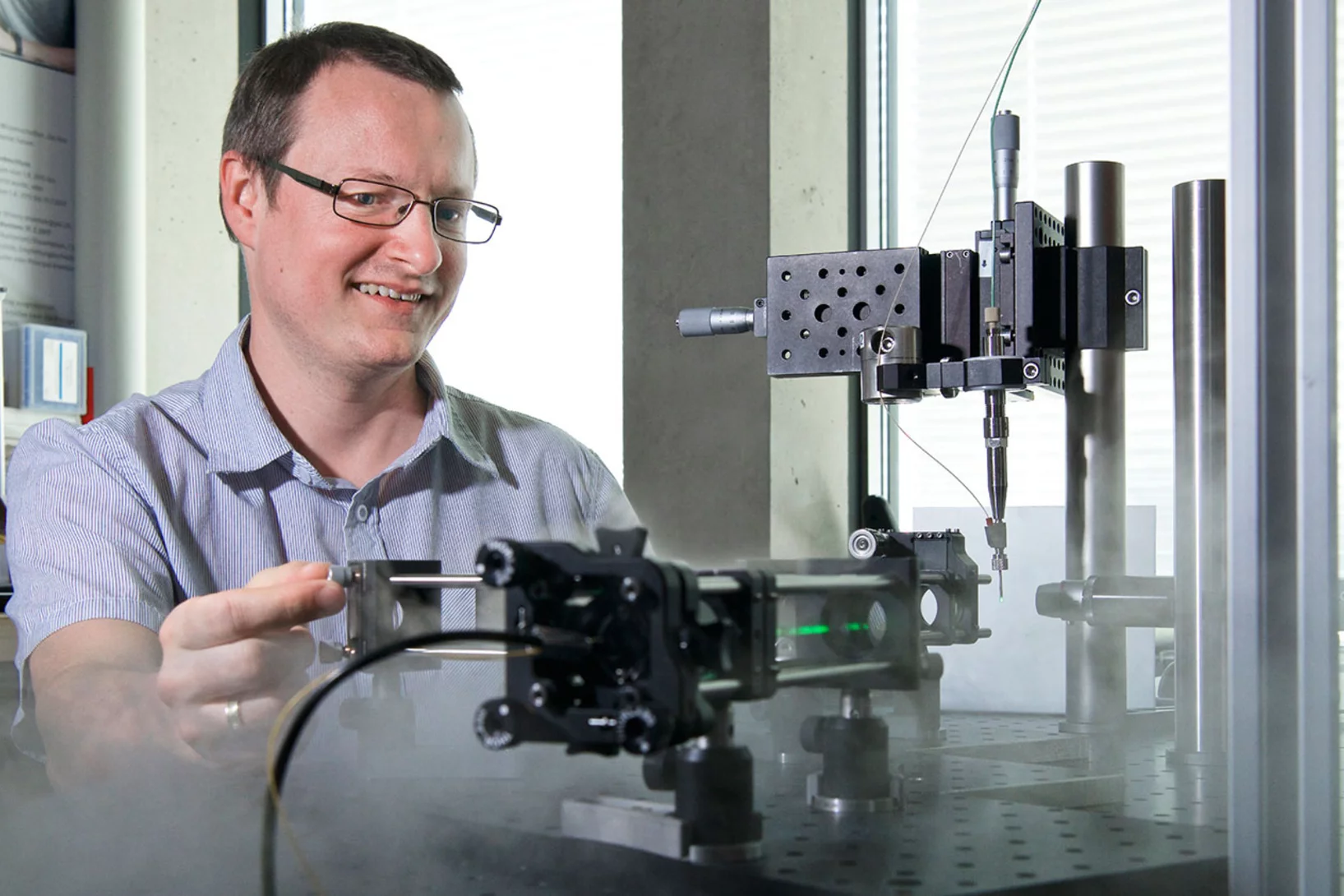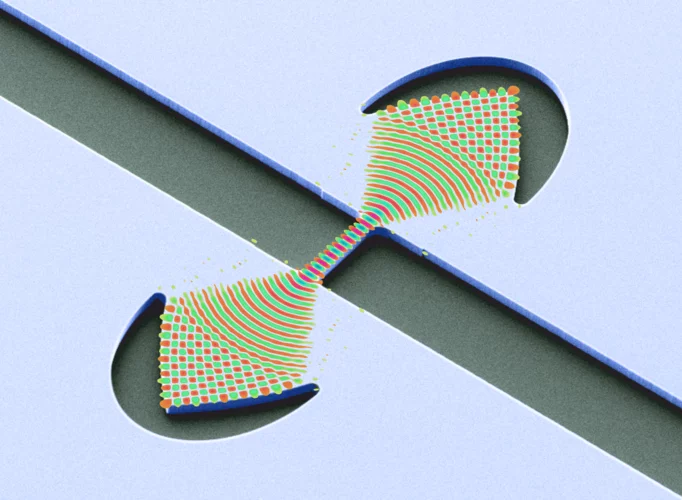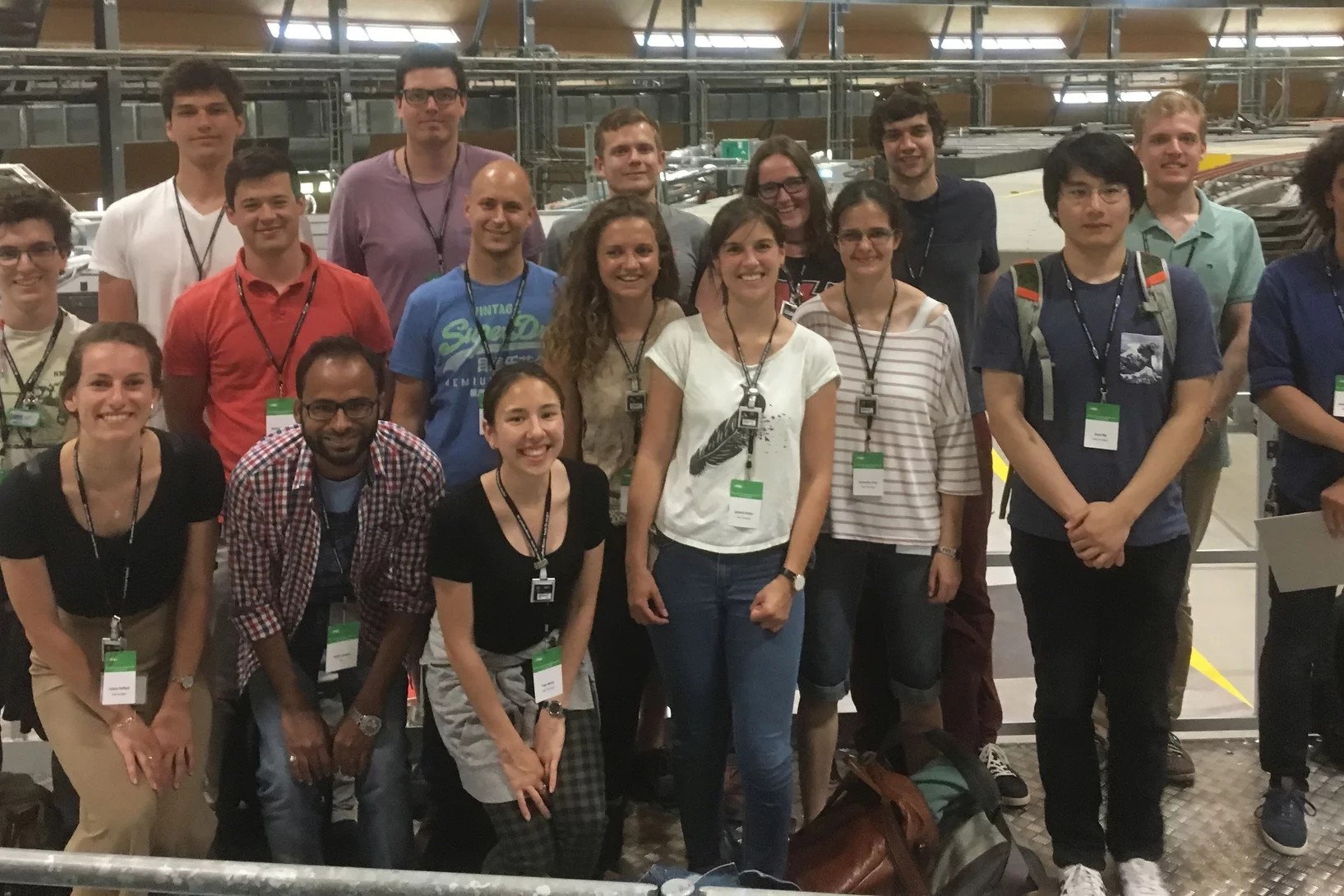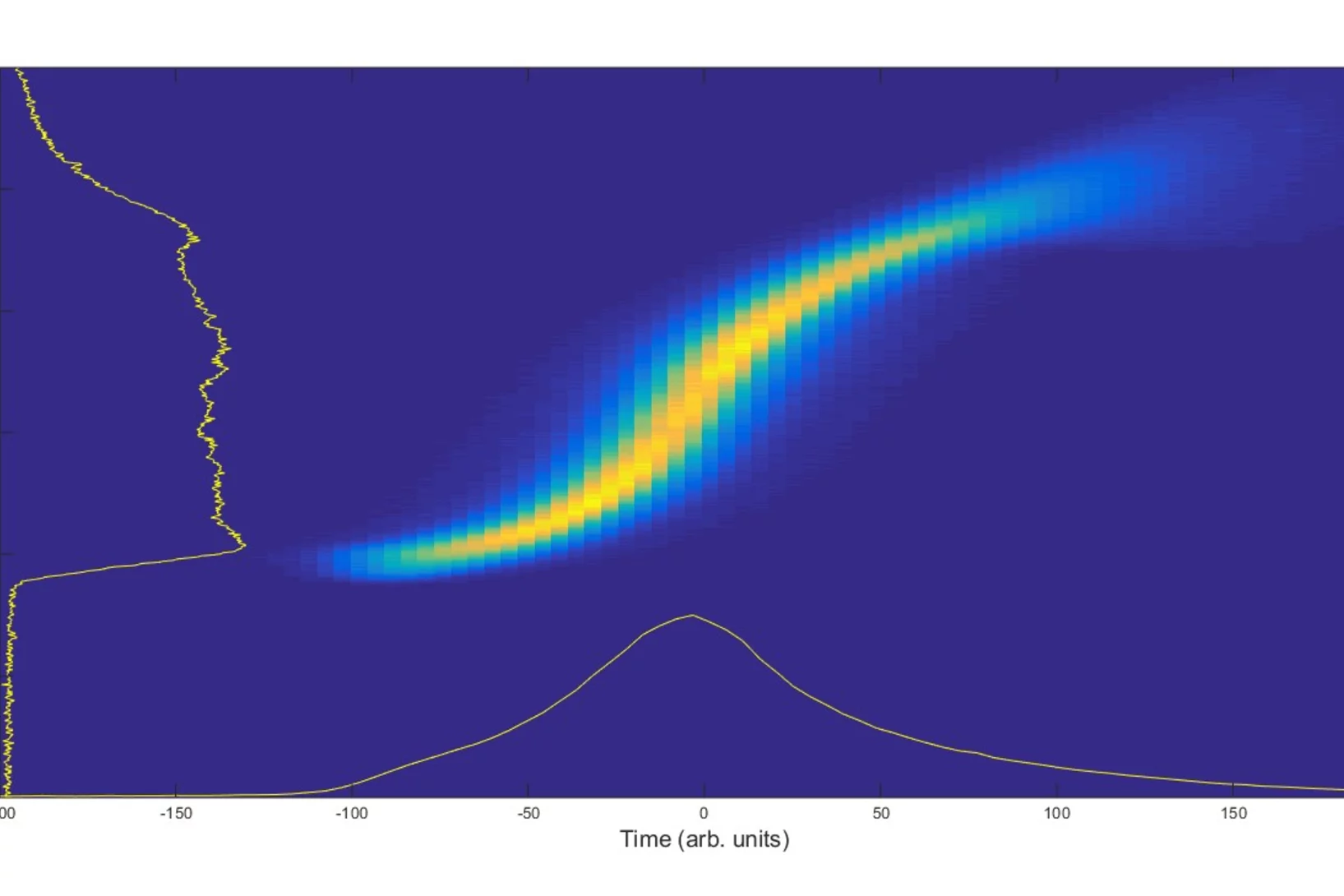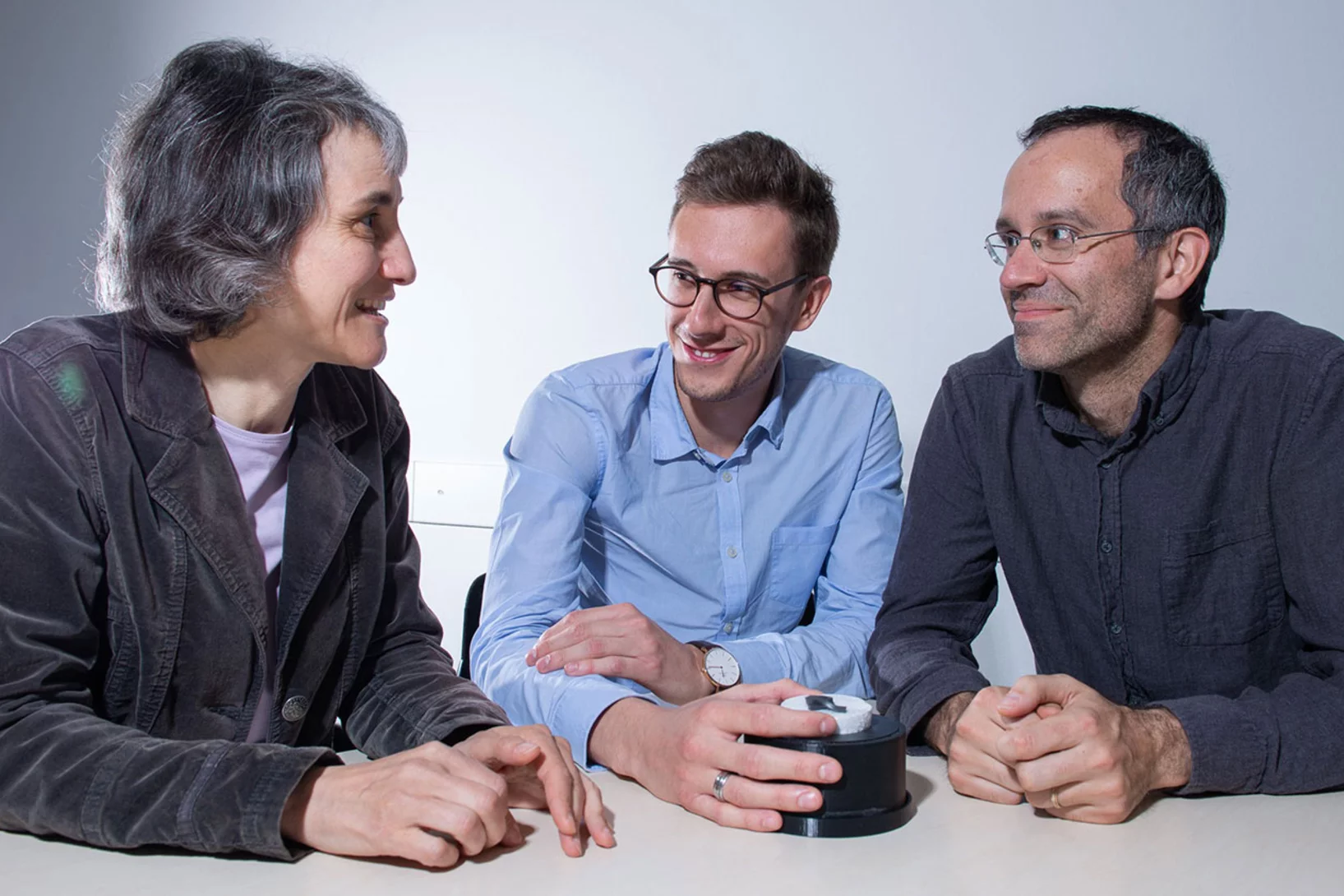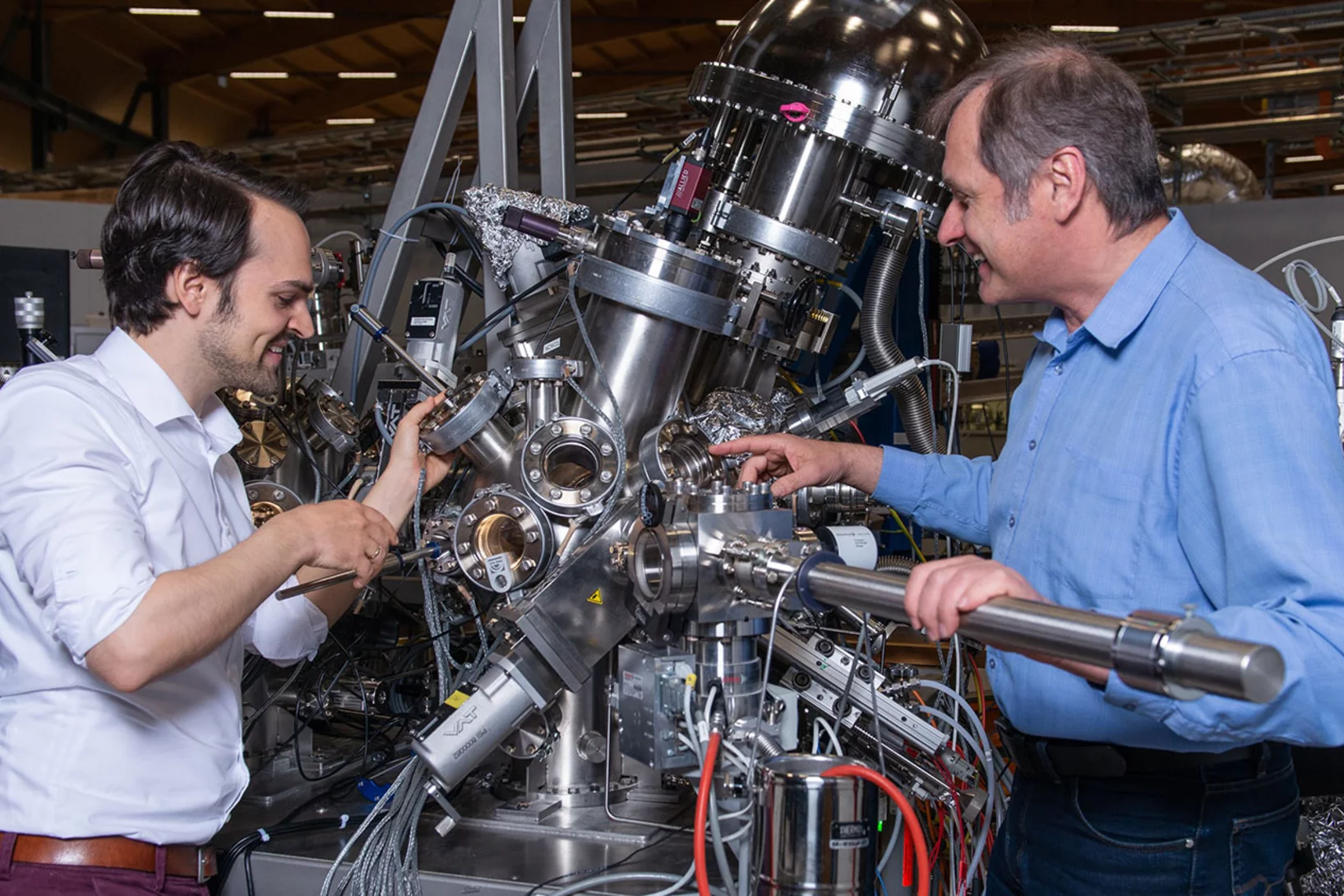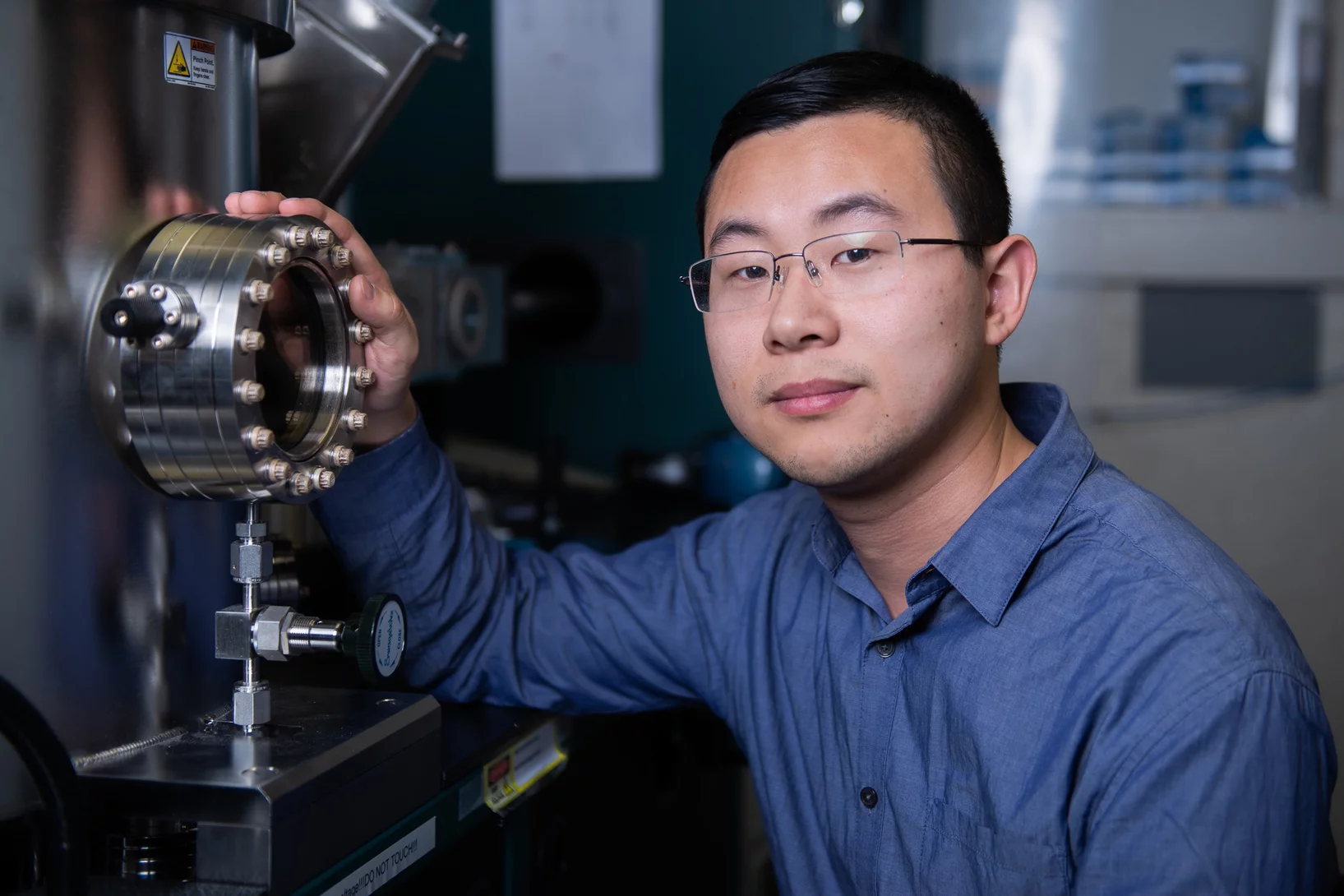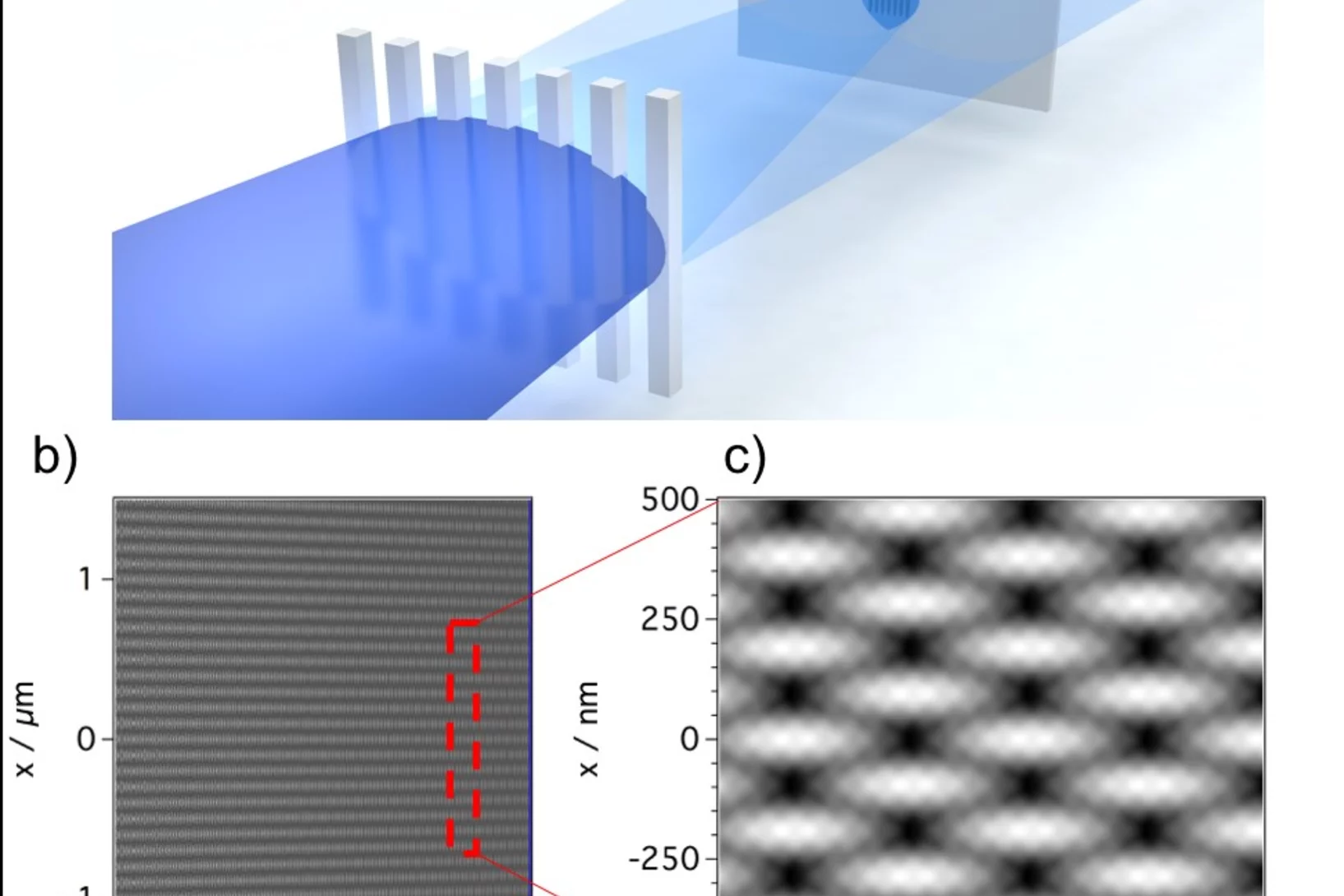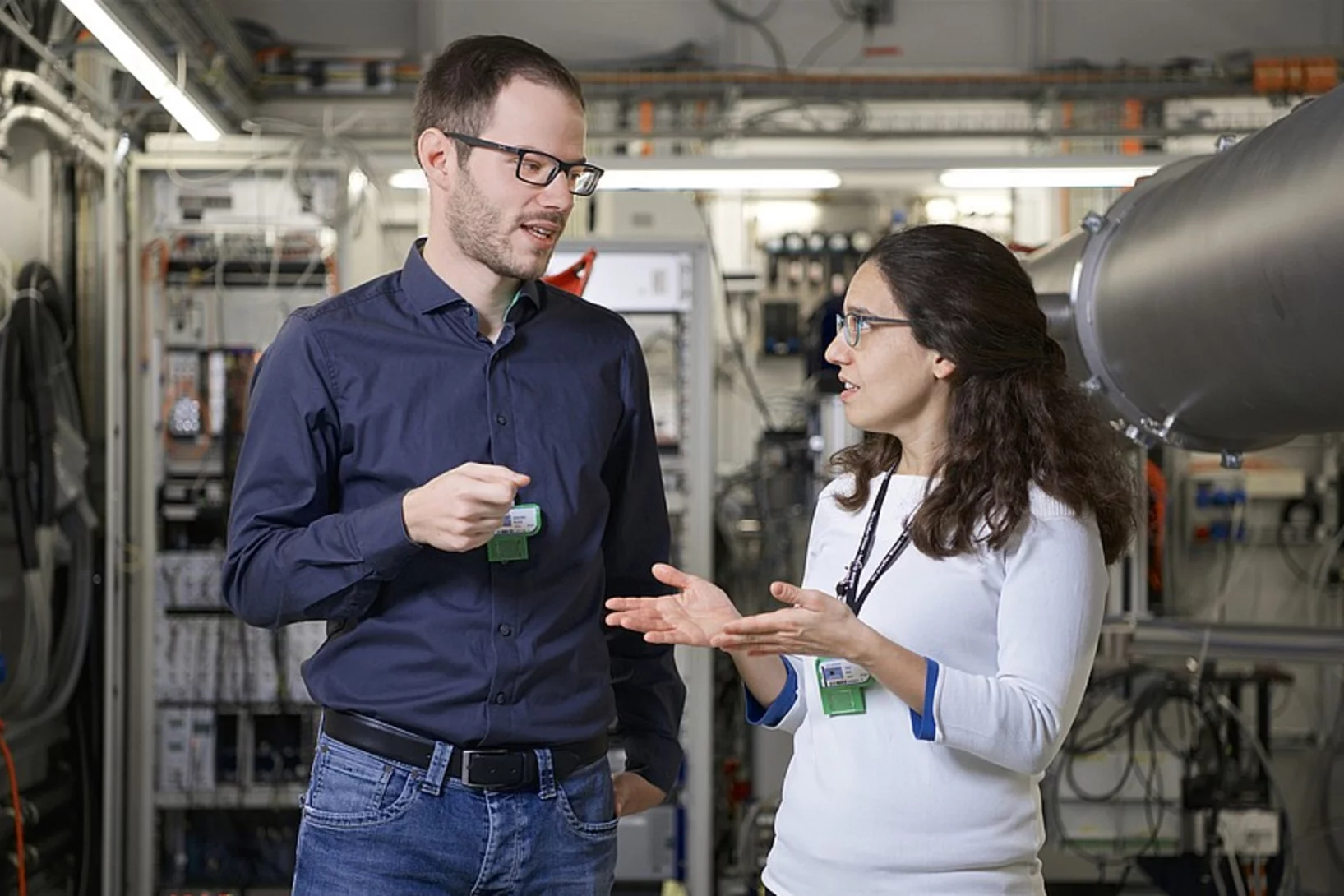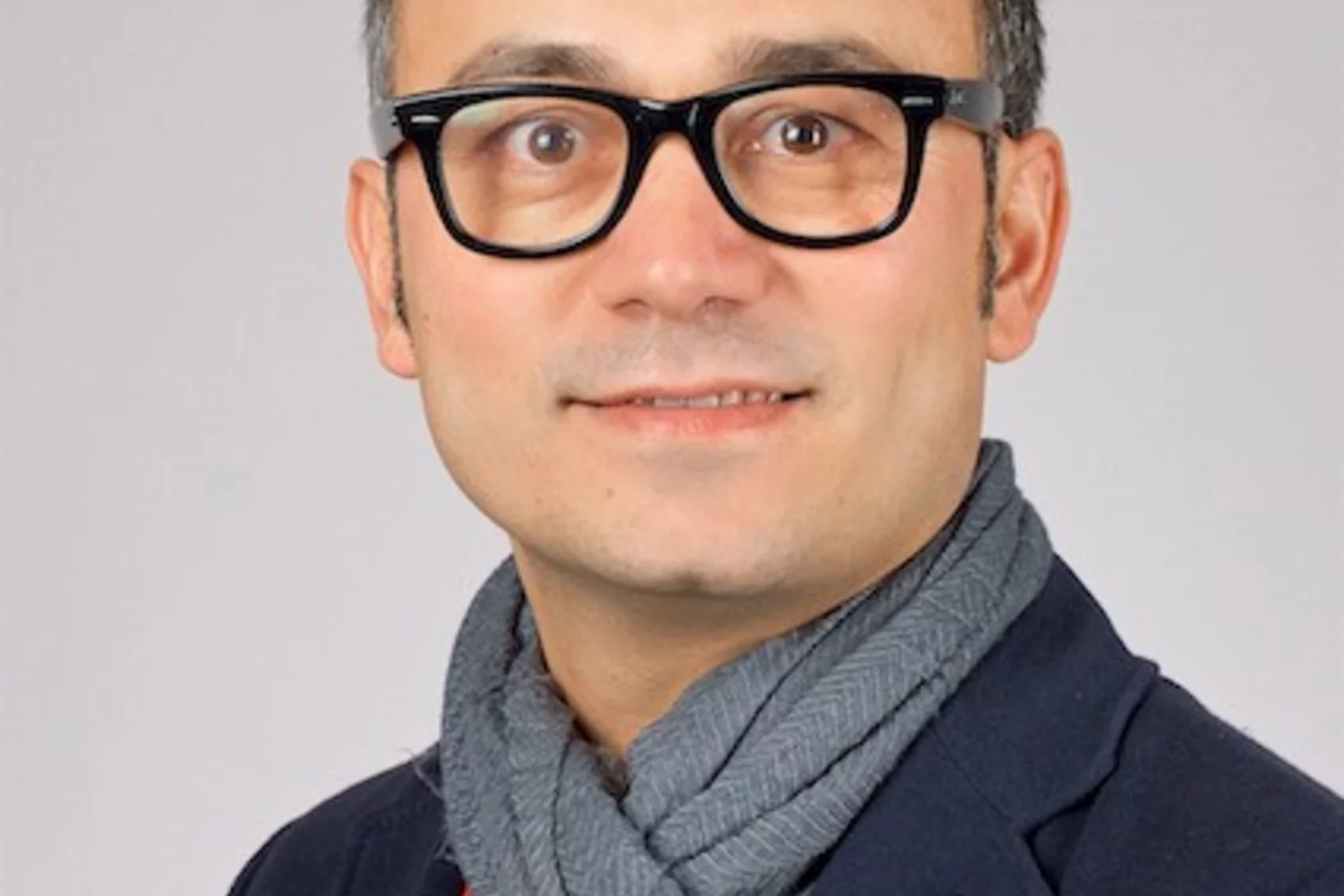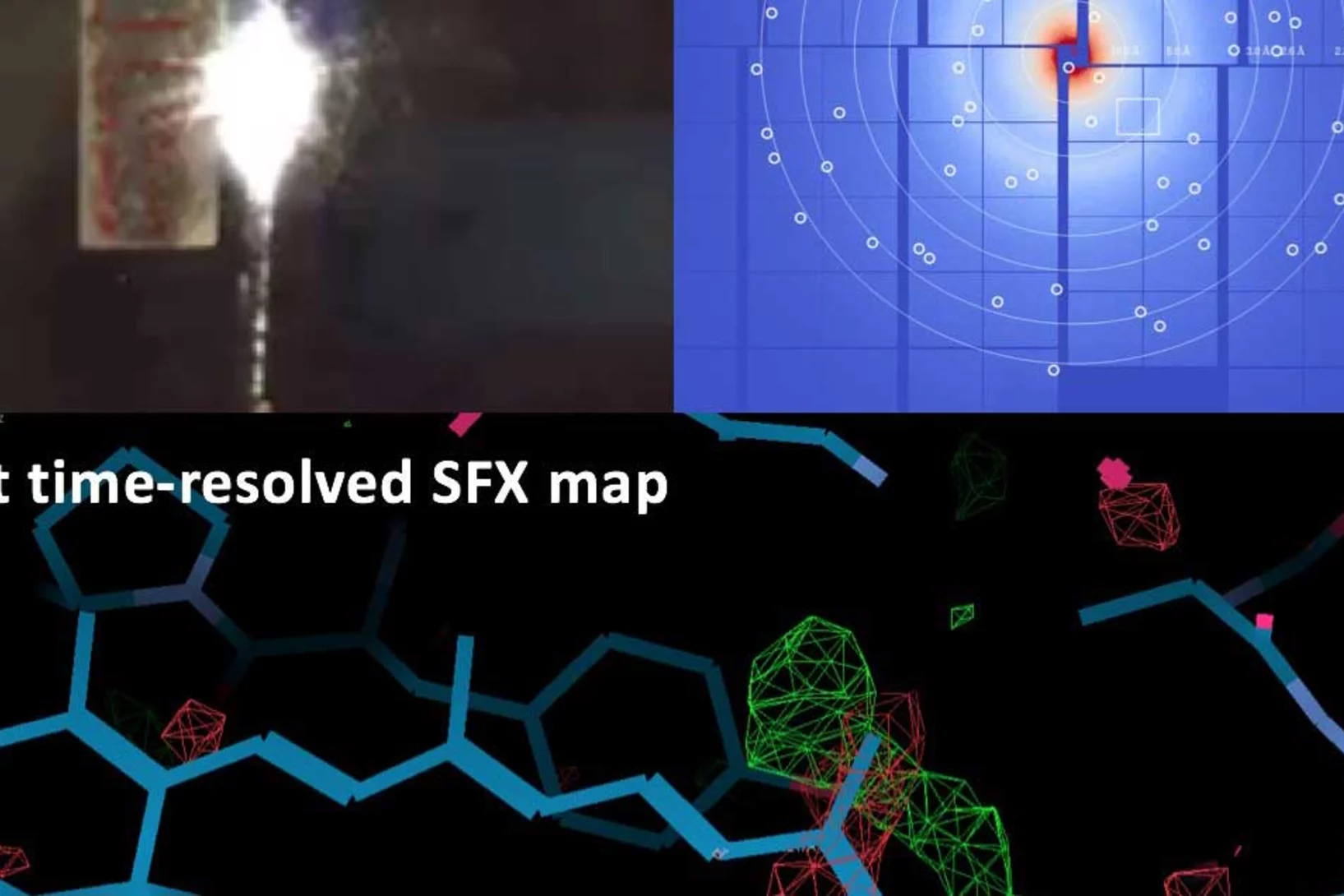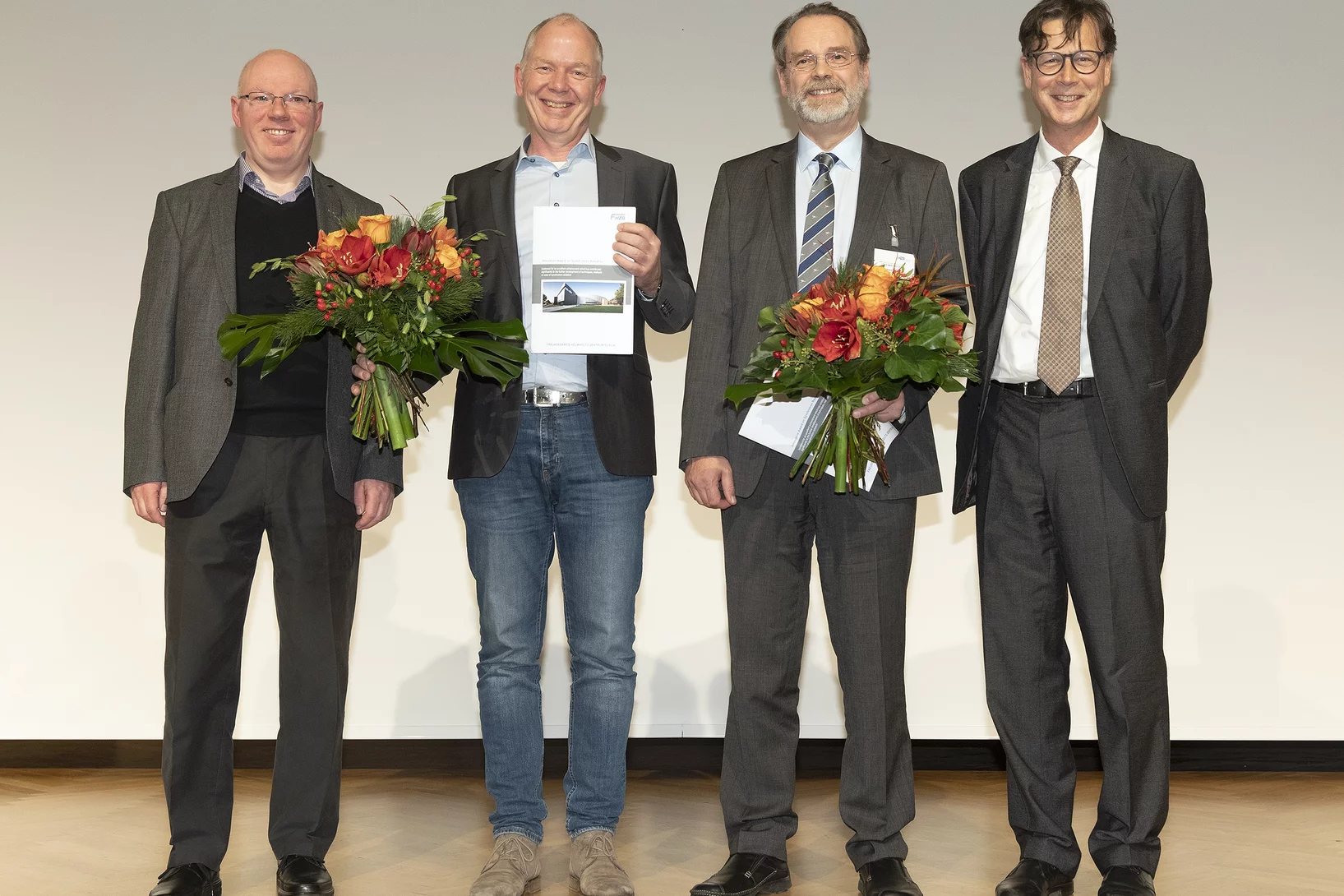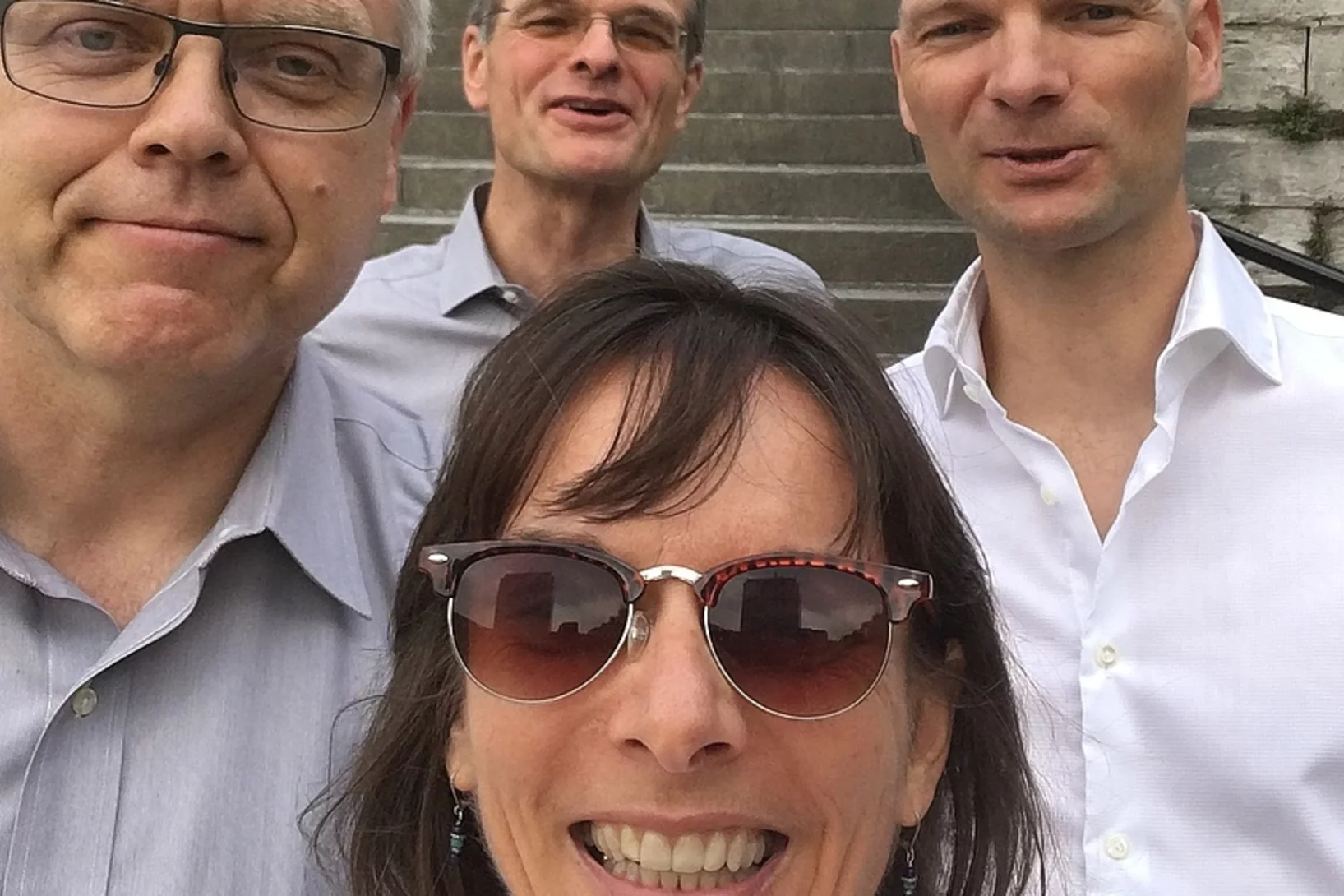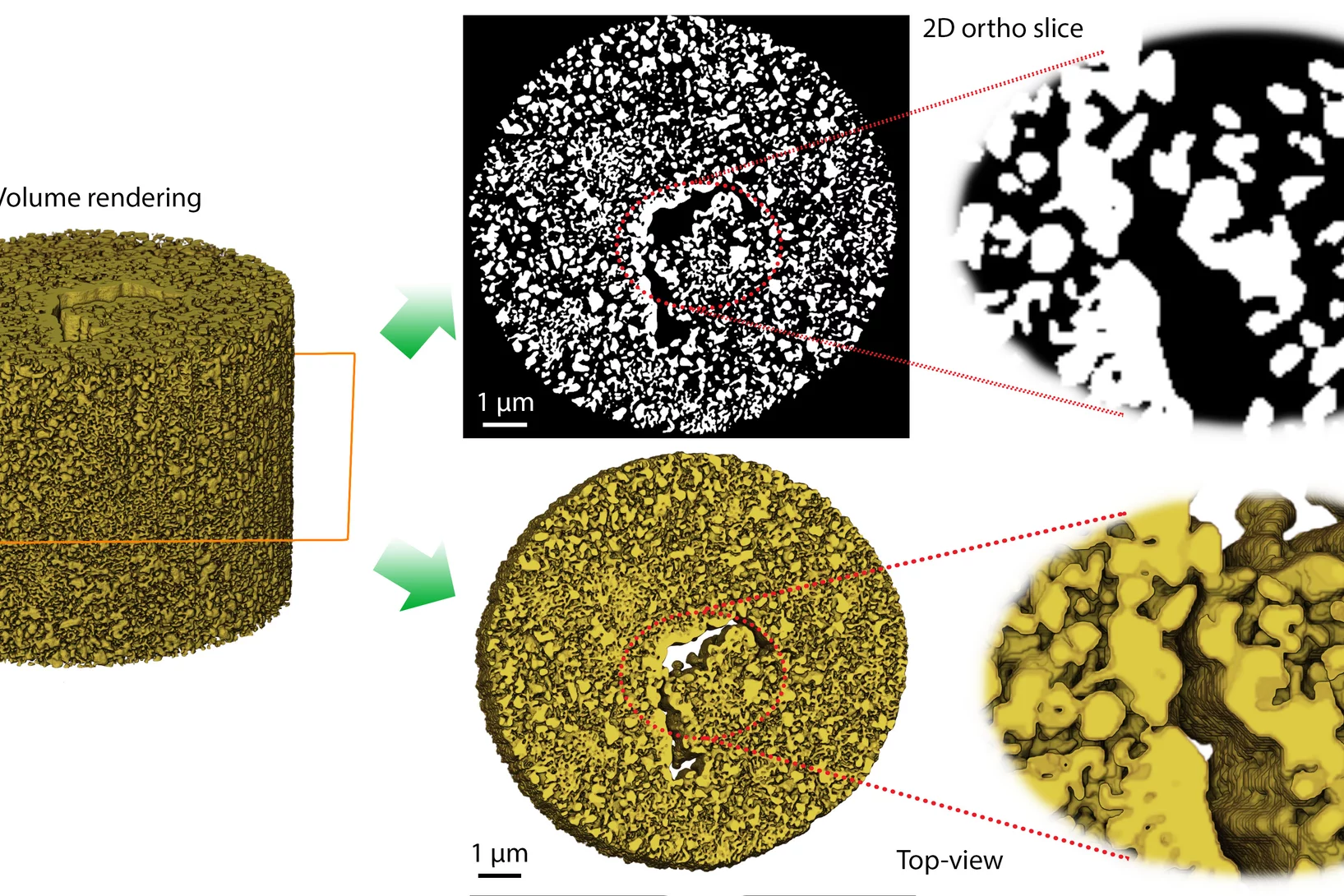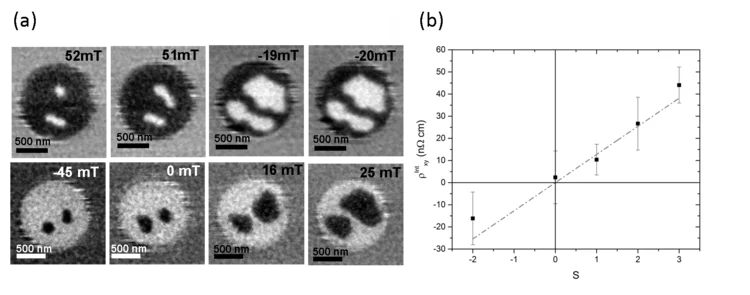Court-métrage d’un nano-tourbillon magnétique
Des chercheurs ont développé une nouvelle méthode d’analyse qui leur a permis de visualiser la structure magnétique à l’intérieur d’un matériau à l’échelle du nanomètre. Ils ont réussi à réaliser un petit «film» de sept images qui montre pour la première fois en 3D les changements que de minuscules tourbillons magnétiques subissent au cœur du matériau.
Innovation Award on Synchrotron Radiation 2019 for the development of XFEL detectors using the adaptive gain principle
The Innovation Award on Synchrotron Radiation 2019 was given to the researchers Prof. Heinz Graafsma from Desy and Dr. Aldo Mozzanica and Dr. Bernd Schmitt both from the Paul Scherrer Institute. The three physicists were honored for their contributions to the development of detectors for XFEL applications based on the dynamic gain switching principle enabling simultaneously single photon resolution and a large dynamic range. The laudation was held by Prof. Edgar Weckert from Desy. The Synchrotron Radiation Innovation Award is sponsored by SPECS GmbH and BESTEC GmbH.
Ultrafast diffuse x-ray scattering of a hybrid perovskite crystal
Organic–inorganic ‘hybrid’ perovskites have recently gained attention as a low-cost alternative to silicon solar cells. However, many properties of these materials are still poorly understood. In particular, how imperfections in the crystals, which can be both static or dynamic, affect energy transport remains unclear.
SLS 2.0: l’upgrade de la Source de Lumière Suisse SLS
Au cours des prochaines années, la Source de Lumière Suisse SLS fera l’objet d’un upgrade: la SLS 2.0. Cette transformation rendue possible par de la technologie dernier cri donnera une grande installation de recherche à la hauteur des besoins des chercheurs pour les prochaines décennies.
Radiographier rapidement et précisément des matériaux composites renforcés de fibres
Des chercheurs de l’Institut Paul Scherrer PSI ont mis au point une méthode de diffusion des rayons X aux petits angles qui peut être utilisée pour le développement ou le contrôle qualité de matériaux composites novateurs renforcés de fibres. Grâce à elle, les analyses de ces matériaux pourraient se faire à l’avenir non seulement par recours aux rayons X issus de sources puissantes comme la Source de Lumière Suisse SLS, mais aussi avec le rayonnement issu de tubes à rayons X conventionnels.
New 6M€ European grant awarded to ExPaNDS to drive open access data
A new 6M€ grant is being launched for the Photon and Neutron Data Services (ExPaNDS) to come together and work under the European Open Science Cloud (EOSC). This ambitious project will create enormous opportunities for scientific communities, and through their findings for humankind worldwide. It aims to publish and map the data behind the thousands of successful published scientific papers generated by Europe’s Photon and Neutron Research Infrastructures (PaN RIs) – which every year create petabytes of data – and make it available to all.
Recherche et optimisation – le SwissFEL en 2019
La plus récente grande installation de recherche du PSI, le SwissFEL, est achevée. Elle a commencé à fonctionner normalement en janvier 2019. Henrik Lemke, responsable du groupe SwissFEL Bernina, tire un premier bilan.
Empêcher la formation des métastases des tumeurs
Des chercheurs de l’Institut Paul Scherrer PSI ont, en collaboration avec des collègues de la firme pharmaceutique F. Hoffmann-La Roche SA, franchi un pas important dans le développement d’une substance active contre la formation des métastases de certaines tumeurs cancéreuses. Grâce à la Source de Lumière Synchrotron Suisse SLS, ils ont déchiffré la structure d’un récepteur qui joue un rôle essentiel dans la migration des cellules cancéreuses.
Des fermions de Weyl découverts dans une nouvelle classe de matériau
Jusqu’ici, l’existence de particules d’un genre spécial appelées fermions de Weyl n’avait pu être démontrée que dans certains matériaux non magnétiques. Mais des chercheurs du PSI ont maintenant réussi pour la première fois à prouver expérimentalement leur présence dans un matériau paramagnétique particulier.
La star à l’écran: une machine moléculaire
Des chercheurs de l’Institut Paul Scherrer PSI ont filmé une machine moléculaire en mouvement grâce à la Source de Lumière Suisse SLS, et ainsi révélé comment fonctionne la production d’énergie au niveau des cellules membranaires. Ils ont développé à cet effet une nouvelle méthode qui pourrait permettre des succès inédits dans l’analyse des processus cellulaires.
First demonstration of a Germanium laser
Scientist at the Paul Scherrer Institut and ETH Zürich, with colleagues from CEA Grenoble, have demonstrated and characterized a technology that, for the first time, yields lasing from strained elemental Germanium. This achievement underlines PSI’s leading role in the development of Silicon-compatible laser light sources.
PSI School for Master Degree Students - Introducing Photons, Neutrons and Muons for Condensed Matter Physics and Materials Science
From 17 – 21 June 2019 the Neutron and Muon Division (NUM) and the Photon Science Division (PSD) of PSI hosted 18 Master Degree students of physics, chemistry, materials and interdisciplinary science, as well as nuclear engineering to provide an introduction to the characterization of materials with large scale facilities like SINQ, SμS, SLS and SwissFEL. The course taught a basic understanding of how photons, neutrons and muons interact with matter, and how this knowledge can be used to solve specific problems in materials research.
Details of the program can be found at http://indico.psi.ch/event/PSImasterschool
First serial femtosecond crystallography experiment using SwissFEL’s large bandwidth X-ray pulses
The typical mode of operation at XFEL facilities uses the so-called self-amplified spontaneous emission (SASE) process to generate the short, bright X-ray pulses. This mode of operation is stochastic in nature, causing some variance in intensity and spectrum on a shot-to-shot basis, which makes certain types of crystallographic measurements much more challenging.
Nouveau matériau avec mémoire de forme magnétique
Des chercheurs du PSI ont développé un matériau dont la mémoire de forme est activée par magnétisme. La médecine, la navigation spatiale, l’électronique ou encore la robotique constituent autant de domaines d’application pour ce nouveau type de matériaux composites.
Un matériau innovant qui présente aussi de nouvelles quasi-particules
Des chercheurs du PSI ont analysé à la Source de Lumière Suisse SLS un matériau cristallin innovant qui présente des propriétés électroniques encore jamais vues à ce jour. Ils ont entre autres réussi à détecter un nouveau type de quasi-particules appelées fermions de Rarita-Schwinger.
HERCULES school 2019 at SLS
In the week of April 1-5 PSI welcomes 20 PhD students and postdocs taking part in the European HERCULES 2019 school on Neutron and Synchrotron Radiation. They will attend lectures and perform two days of practical courses at several beam lines of the Swiss Light Source.
Une boussole qui indique l'ouest
La Source de Lumière Suisse SLS a permis à des chercheurs du PSI de découvrir que certains groupes d’atomes se comportent comme une boussole qui indique l’est. Ce nouveau phénomène magnétique pourrait rendre les ordinateurs nettement plus performants.
Towards X-ray Transient Grating Spectroscopy at SwissFEL
The high brilliance of new X-ray sources such as X-ray Free Electron Laser opens the way to non-linear spectroscopies. These techniques can probe ultrafast matter dynamics that would otherwise be inaccessible. One of these techniques, Transient Grating, involves the creation of a transient excitation grating by crossing X-ray beams on the sample. Scientists at PSI have realized a demonstration of such crossing by using an innovative approach well suited for the hard X-ray regime.
Observer les électrons et allumer les bits
L’électronique doit rapetisser, devenir plus rapide et surtout moins énergivore. Au PSI, plusieurs groupes de recherche se penchent aussi sur ces thématiques. Des améliorations graduelles à la réorientation totale: voici un aperçu de qui travaille sur quoi en ce moment.
Une lentille virtuelle améliore la microscopie à rayons X
Une nouvelle méthode développée par des chercheurs du PSI permet d’améliorer encore les radiographies de matériaux. Pour ce faire, les chercheurs ont déplacé une lentille optique et réalisé chaque fois une image individuelle. A partir de là, ils ont calculé une image globale à l’aide d’algorithmes informatiques.
Le moment est venu de passer à autre chose
Si l’on réduit le format des composants électroniques, malheureusement, ils chauffent. En termes de miniaturisation, la limite du techniquement faisable sera aussi bientôt atteinte. Au PSI, Gabriel Aeppli et Christian Rüegg travaillent à de nouvelles solutions physiques pour améliorer les performances des mémoires de données et des ordinateurs.
Dr Yasin Ekinci elected as Fellow of SPIE
Dr. Yasin Ekinci, Head of the Advanced Lithography and Metrology Group and ad interim Head of the Laboratory for Micro and Nanotechnology, has been elected to the grade of Fellow of The International Society for Optics and Photonics (SPIE).
Dr Mirjam van Daalen appointed as Swiss ESFRI delegate
Dr. Mirjam van Daalen Chief of staff of the Photon Science Division, was mandated on the 1st of January 2019, by the State Secretariat for Education, Research and Innovation SERI as a member of the Swiss Delegation to the European Science Forum on Research Infrastructures ESFRI https://www.esfri.eu/.
SESAME beamline for tomography project (BEATS) is launched
On 1st January 2019, the European Horizon 2020 project BEAmline for Tomography at SESAME (BEATS) was launched with the objective to design, procure, construct and commission a beamline for hard X-ray full-field tomography at the SESAME synchrotron in Jordan. The European grant is worth 6 million euros and will span a four-year period from beginning 2019 to end 2022.
First femtosecond protein pump-probe measurements at SwissFEL
A major milestone in the commissioning of SwissFEL has been reached: the first pump-probe experiments on proteins have been successfully carried out. Crystals of several retinal-binding proteins were delivered in a viscous jet system and a femtosecond laser was used to start the isomerization reaction. Microsecond to sub-picosecond snapshots were then collected, catching the retinal proteins shortly after isomerization of the chromophore.
2018 Innovation Award on Synchrotron Radiation
The Innovation Award on Synchrotron Radiation 2018 went to Dr. Christian David, also from the Paul Scherrer Institute, and to Prof. Alexei Erko, who recently moved from the HZB to the Institute for Applied Photonics (IAP) in Berlin-Adlershof.
L'UE accorde 14 millions à des chercheurs suisses
Une prestigieuse bourse de l’Union européenne a été décernée à une équipe incluant trois chercheurs du Domaine des EPF. Les scientifiques ont reçu aujourd’hui le contrat signé de l’UE qui confirme ce financement exceptionnellement important de 14 millions d’euros. Ce montant va leur permettre d’étudier certains effets quantiques qui pourraient constituer l’épine dorsale de l’électronique du futur.
Helping chemists to understand degradation and stabilization of catalytic nanoporous gold structures
Catalytic materials are ubiquitously used in industrial processes to perform chemical reactions efficiently and in a sustainable manner. Nanoporous gold (npAu) is a monolithic sponge-like catalyst exhibiting a hierarchical structure with pores and connecting ligaments of typically 10 to 50 nm.
SwissFEL's First Call for Proposals
The first SwissFEL call for proposals took place, deadline for submission was the 15th of September. In this first call for proposals SwissFEL received overwhelming interest from the user community. A total of 47 proposals were submitted for the SwissFEL Alvra experimental station and 26 for the Bernina experimental station. The Proposal Review committee PRC took place on 18-19 October 2018.
Discrete Hall contribution of magnetic skyrmions
The reliable electrical detection of magnetic skyrmions is of fundamental importance for the application of such topological magnetic quasi-particles for data storage devices. Researchers in a joint collaboration between the University of Leeds and the PolLux endstation have investigated the electrical detection of isolated magnetic skyrmions in applications-relevant nanostructured devices, observing the presence of a strong skyrmion-dependent contribution to the Hall resistivity.


